Royal Holyn Marines
| Royal Holyn Marines | |
|---|---|
| Kráľovský Holynske Mariňákov | |
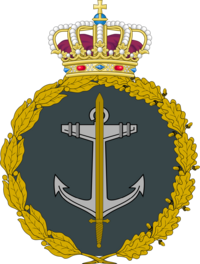 Emblem of the Royal Holyn Marines | |
| Founded | 22 July 1721 (as Naval Regiment) |
| Country | |
| Type | Marines |
| Role | Amphibious warfare, coastal defense |
| Size |
|
| Part of | |
| Colors | Black, Red |
| Anniversaries | Day of the Marine |
| Engagements | |
| Commanders | |
| Commander | Colonel General Andrej Tureček |
| Chief of Staff and First Deputy commander | Colonel General Jáchym Zdráhal |
| Notable commanders | Lt. General Josef Janoušek |
| Insignia | |
| Flag |  |
| Badge | 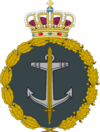 |
| Holyn Kingdom Defence Forces |
|---|
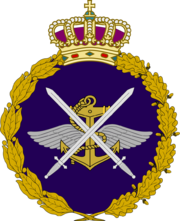 |
| Command |
| Staff |
| Services |
| Geographic Commands |
|
| Specialist Commands |
|
| History of the Holyn military |
The Royal Holyn Marines (Hornatyian: Kráľovský Holynske Mariňákov), or Marines (Hornatyian: Mariňákov), is the amphibious warfare branch of the Royal Holyn Defence Forces. Originally part of the Holyn Navy as the Holyn Naval Infantry, the branch became independent from the Navy in 2003. This saw a significant expansion in the size of the Marines. It consists of 45,000 active personnel, supported by 20,000 reserve personnel. The Royal Marines is made up of five brigades capable of combined arms operations and supporting regiments of aviation, combat engineering, and artillery. The Royal Holyn Marines, along with the Holyn Airborne Assault Forces comprise the quick reaction forces of the Holyn military.
History
Holyn Kingdom
On July 22, 1721, the Naval Regiment was formed by the Holyn Admiralty as the land regiment of the Royal Holyn Navy. The Regiment used the rank structure of the Navy and was led by Naval officers. It was largely a temporary force, only being formed prior to specific naval operations. It would be made up of sailors transferred from ships and other units. It was often thought of as a demeaning and often unpopular unit to be assigned to. In 1761, the Naval Regiment increased to Corps size, totalling roughly 40,000 sailors and officers. It The force attained the official name of Naval Infantry Corps in 1764. During the 10 years war in Spero, the Navy Infantry conducted little to no amphibious operations, instead fighting alonside the ground forces as regular infantry. The Navy infantry during this time expanded, becoming a permanent force within the Navy. The Naval Infantry was instrumental in Holynia's expeditionary operations in Navron during the 19th century. Along with armed units of privateers hired by charted trading companies, the Naval Infantry participated in the seizure of north western Navron in 1824. Aside from its land operations, the naval infantry was tasked with guard duties of officers and enforcing order among sailors. In 1859, the Naval Infantry converted from Naval enlisted ranks to a rank structure mirroring the Holyn Army. Officers retained a Naval like structure, but suffered from a lower status in comparison to a full-fledged Navy officer.
In 1917, the Naval Infantry was an instrumental force for the Holyn government during the Great Spero War. Several succesful landing operations were conducted in western Spero which allowed the Central Alliance to gain the upper hand towards the end of the war.
During the Holyn Civil War in 1927, the Naval Infantry remained loyal to the monarchy. Despite several defections, the Naval Infantry were one of the last forces left fighting for the Monarchy in Holynia. Naval Infantry troops were tasked with the defense of Slatnik, the temporary residence of the Royal Family. They provided security during the Great Escape of 1927, when the Royal Family, most of the loyalist troops and wealthy individuals, fled to the overseas Holyn territory of Skoskie. Roughly 1,000 Naval Infantrymen remained behind and waged an insurgency in southern Masovia until mid 1928. The routed Loyalists rebuilt their forces in Skoskie, including the Naval Infantry. The Communists did not field a Naval Infantry force in the early years.
Holyn Socialist States
In 1943, the 37th Naval Rifle Regiment was formed in Slatnik by orders of the Holyn Navy Commander, Admiral of the Fleet Jakub Kočiš. This constituted the first Naval Infantry regiment in Holynia since 1927. A second regiment was formed in Plotny in 1945, the 40th Naval Rifle Regiment. Two more Naval Rifle Regiments were formed in 1946. In 1947, the 7th Naval Infantry Division was created. Shortly after the 7th Naval Infantry Division was formed, the Holyn leadership decided to support the overseas communist rebellion in Salcheny, a colony of Pamtoria. The 37th Naval Rifle Regiment and 53rd Naval Rifle Regiment were deployed in support of the rebellion, arriving in Port Vola on 17 September 1947. These troops spearheaded an assault on pro-Pamtorian positions, effectively handing victory to the Salcheny communists. The 37th and 53rd Naval Rifle Regiments both received the honorific title of Guards, and the Order of the Red Carnation, as a result of their actions in Salcheny.
In 1951, all Naval Infantry Regiments were reformed simply as Naval Infantry Regiments, removing the Rifle designation. The Naval Infantry increased in size during the 1950s, largely to support foreign expeditionary operations in Navron. A rivalry formed during this period, as the Holyn Airborne Assault Troops, the other shock force troops of the Holyn military, began to similarly increase in size. In 1951, the Naval Infantry and Holyn Airborne Assault Troops both supported the communist revolution in Movargovina.
The Navy introduced several new landing ships in the 1960s, representing a major step forward in capabilities for the Naval Infantry. A reorganization of the Naval Infantry took place in 1972. All regiments were transformed into brigades, and the 7th Naval Infantry Division became the 7th Naval Infantry Corps. This was part of a broader push to reorganize the Holyn military. However, in 1975, Defense Minister Oliver Rušil abandoned these plans and reverted the 7th Naval Infantry Corps back into a Division. Brigades reverted back into regiments. The reformation plan largely affected command staff, rather than front line personnel.
Throughout the 1980s, the Naval Infantry gradually expanded their capabilities. They adopted new vehicles such as the BVP-2 infantry fighting vehicle. The Holyn Navy began development of a landing helicopter dock/amphibious assault ships, Project 1600 amphibious assault ships. These ships would be able to carry up to 1,000 naval infantrymen and 40 armored vehicles.
During the Bogorian War of Independence, the Holyn Naval Infantry were heavily involved in the fighting. Operational groups of the Naval Infantry were present in the Battle of Pavířov. A battalion of the Naval Infantry were also present in the Battle of Gniewkowo.
Second Holyn Kingdom
The Naval Infantry saw great setbacks during the early 2000s. Funding decreases, combined with losses during the Bogorian War, resulted in a reduction in size and scope of the Naval Infantry between 2000 and 2002. In 2003, the Ministry of Defence announced the Naval Infantry would become a seperate troops branch, similar to the Airborne Assault Forces. To coincide with this, the Naval Infantry were renamed the Mariňákov or Marines.
Aside from the name change, organizational and rank restructuring took place. The Marines replaced the last vestiges of Navy ranks, introducing Officer ranks similar to the Ground Forces. Similar to the other branches of the Holyn military, a non-commissioned officer academy was established, based off the Ground Forces. The Marines were the first branch to end conscription in early 2004. The Marines were designated the branch which would serve as the baseline for all other services in the Holyn military. The non-commissioned officer academy began training the first Desátníks in late 2004. The culture shift in the Marines became evident in late 2005, during the Bogorian Border Crisis. The Holyn Marines were able to effectively operate independently and achieved a higher amount of succesful operations.
In 2008, the Marines added their first tank units, a battalion each of main battle tank units to the 37th Guards and 53rd Guards Marine Brigades. Additional tracked armor vehicles were introduced during the 2000s and 2010s to increase the firepower capability of the Marines.
Organization
- Royal Holyn Marines Command - Lužanky, Holynia
- Command Staff of Royal Holyn Marines
- Commander of the Royal Holyn Marines - Colonel General Andrej Tureček
- Seperate Command Regiment - Lužanky, Holynia
- 45th Seperate Signals Brigade
- 79th Seperate NBC Brigade
- Command Staff of Royal Holyn Marines
- 1st Marines Division
- 1st Marines Headquarters Company
- 5th Guards Marines Brigade
- 38th Marines Motor Rifle Battalion
- 15th Guards Marines Motor Rifle Battalion
- 24th Marines Motor Rifle Battalion
- 7th Guards Marines Brigade
- 11th Marines Motor Rifle Battalion
- 17th Marines Motor Rifle Battalion
- 45th Guards Marines Motor Rifle Battalion
- 8th Marines Brigade
- 46th Marines Motor Rifle Battalion
- 72nd Marines Motor Rifle Battalion
- 79th Marines Motor Rifle Battalion
- 7th Guards Marines Artillery Group
- Artillery Headquarters Company
- 71st Marines Artillery Battalion
- 9th Guards Artillery Battalion
- 48th Marines Artillery Battalion
- 105th Marines Artillery Reconnaissance Battalion
- 9th Marines Seperate Security Company
- 11th Seperate Logistics/Supply Battalion
- 4th Marines Tank Battalion
- 34th Amphibious Transport Battalion
- 81st Air Defence Battalion
- 14th Combat Engineering Battalion
- 27th Reconnaissance Battalion
- 9th Signals Battalion
- 7th Marines Support Brigade
- 73rd Logistics/Supply Battalion
- 15th Maintenance Battalion
- 2nd Marines Division
- 2nd Marines Headquarters Company
- 6th Marines Brigade
- 17th Marines Motor Rifle Battalion
- 2nd Guards Marines Motor Rifle Battalion
- 34th Guards Marines Motor Rifle Battalion
- 27th Marines Brigade (Reserve)
- 105th Marines Motor Rifle Battalion
- 131st Marines Motor Rifle Battalion
- 207th Marines Motor Rifle Battalion
- 31st Marines Brigade (Reserve)
- 103rd Marines Motor Rifle Battalion
- 191st Marines Motor Rifle Battalion
- 197th Marines Motor Rifle Battalion
- 8th Marines Artillery Group
- Artillery Headquarters Company
- 85st Marines Self-Propelled Artillery Battalion
- 52nd Marines Rocket Artillery Battalion
- 31st Marines Field Artillery Battalion
- 191st Marines Artillery Reconnaissance Battalion
- 11th Marines Seperate Security Company
- 3rd Seperate Logistics/Supply Battalion
- 19th Marines Tank Battalion
- 21st Amphibious Transport Battalion
- 51st Air Defence Battalion
- 13th Reconnaissance Battalion
- 22nd Signals Battalion
- 102nd Logistics/Supply Battalion
- 12th Maintenance Company
- 20th Marines Brigade
- Brigade Headquarters Battalion
- Signals Company
- Air Defence Battery
- Anti-Tank Missile Battery
- Sniper Company
- Electronic Warfare Company
- Unmanned Aerial Vehicle Company
- Sapper Engineer Company
- Material Support Company
- NBC Defence Platoon
- Maintenance Company
- Medical Support Company
- Military Police Company
- 17th Marines Motor Rifle Battalion
- 33rd Marines Motor Rifle Battalion
- 67th Marines Motor Rifle Battalion
- 72nd Marines Reconnaissance Battalion
- 21st Marines Artillery Battalion
- Brigade Headquarters Battalion
- 41st Marines Brigade
- Brigade Headquarters Battalion
- Signals Company
- Air Defence Battery
- Anti-Tank Missile Battery
- Sniper Company
- Electronic Warfare Company
- Unmanned Aerial Vehicle Company
- Sapper Engineer Company
- Material Support Company
- NBC Defence Platoon
- Maintenance Company
- Medical Support Company
- Military Police Company
- 32nd Marines Motor Rifle Battalion
- 39th Marines Motor Rifle Battalion
- 91st Marines Motor Rifle Battalion
- 51st Marines Reconnaissance Battalion
- 71st Marines Artillery Battalion
- Brigade Headquarters Battalion
- 46th Marines Brigade
- Brigade Headquarters Battalion
- Signals Company
- Air Defence Battery
- Anti-Tank Missile Battery
- Sniper Company
- Electronic Warfare Company
- Unmanned Aerial Vehicle Company
- Sapper Engineer Company
- Material Support Company
- NBC Defence Platoon
- Maintenance Company
- Medical Support Company
- Military Police Company
- 82nd Marines Motor Rifle Battalion
- 97th Marines Motor Rifle Battalion
- 98th Marines Motor Rifle Battalion
- 30th Marines Artillery Battalion
- Brigade Headquarters Battalion
Equipment
| Model | Image | Origin | Type | Variant | Number | Details | ||
|---|---|---|---|---|---|---|---|---|
| Main Battle Tanks | ||||||||
| HT-90 Pružný |  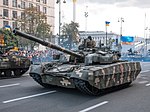
|
125mm main battle tank | HT-90BM
HT-90VM |
Active: 76 Reserve: 13 Active: 42 |
Specialised Marine variants. | |||
| HT-85 | 
|
125mm main battle tank | HT-85BV | Active: 31 | ||||
| Infantry fighting vehicles | ||||||||
| OBV-4 | 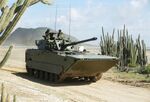
|
Amphibious infantry fighting vehicle | OBV-4A | Active: 104 | ||||
| OBV-3 | 
|
Amphibious infantry fighting vehicle | OBV-3A | Active: 76 | ||||
| BVP-3 | 
|
Infantry fighting vehicle | BVP-3A | Active: 91 | ||||
| Armored personnel carriers | ||||||||
| OT-6 | 
|
Armored personnel carrier | OT-6A | Active: 176 Reserve: 25 |
||||
| OT-5 | 
|
Armored personnel carrier | OT-5A | Active: 62 Reserve:191 |
||||
| OOT-3 | 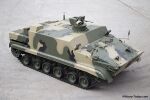
|
Armored personnel carrier | OOT-3 | Active: 31 | ||||
| OOT-2 | 
|
Armored personnel carrier | OOT-2 | Active: 57 Reserve:104 |
||||
| Light armored vehicles (Active: 3,955) | ||||||||
| LOT-150 |  |
Mine-Resistant Ambush Protected Vehicle | LOT-150 | Active: 561 | ||||
| LOT-120 | 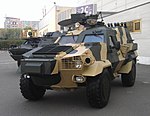 |
Armored car | LOT-120 | Active: 720 | ||||